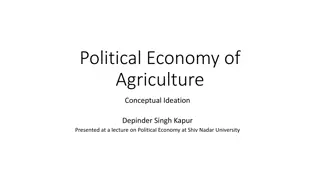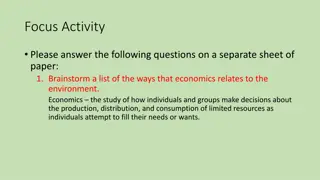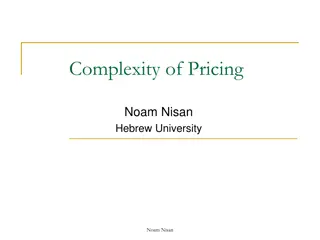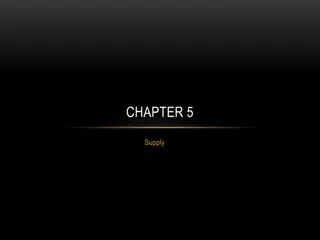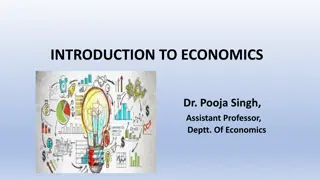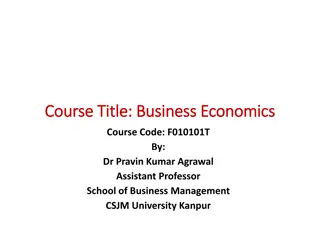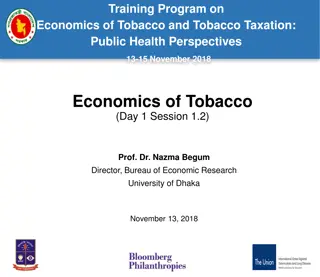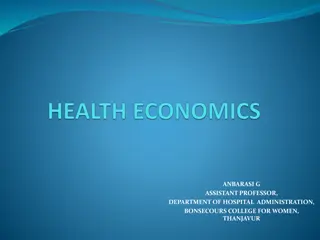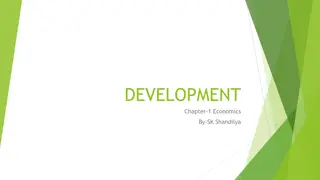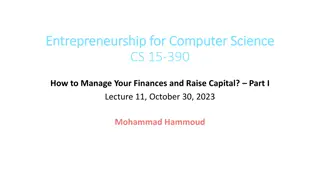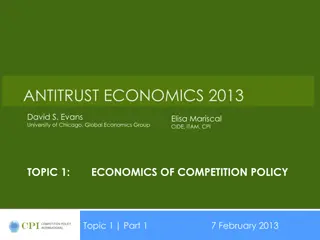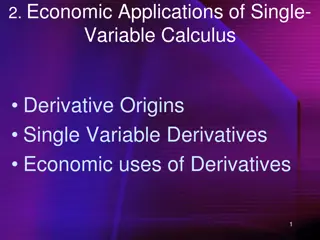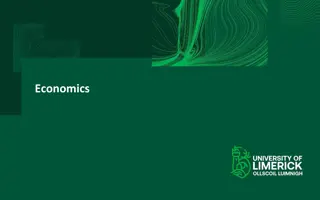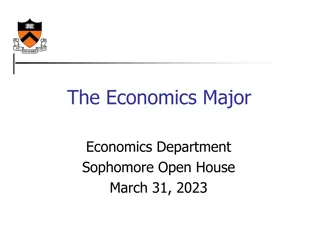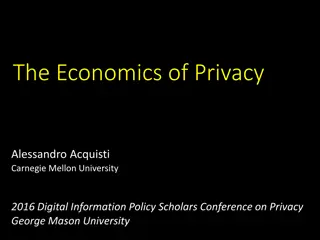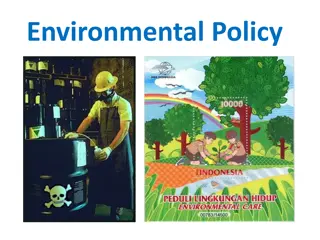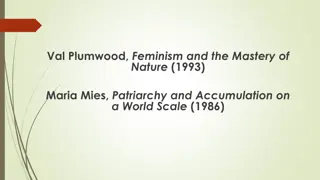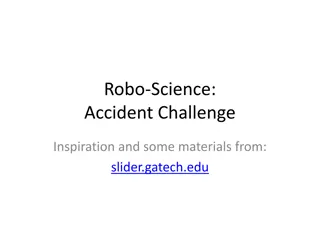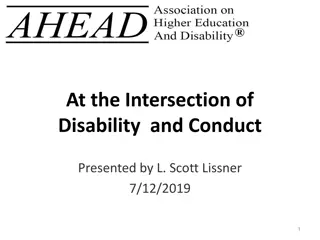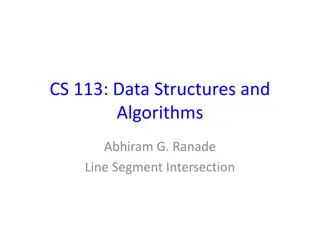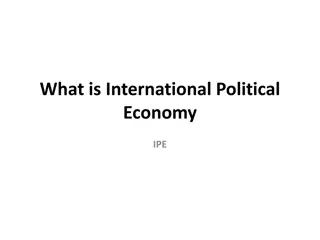Understanding the Intersection of Economics and the Environment
Environment comprises all elements, both living and non-living, that encompass an organism, including humans. This includes the natural environment, which encompasses all biotic and abiotic components around us. Understanding the economic implications of environmental factors is crucial for sustainable development and the well-being of both current and future generations.
Download Presentation

Please find below an Image/Link to download the presentation.
The content on the website is provided AS IS for your information and personal use only. It may not be sold, licensed, or shared on other websites without obtaining consent from the author. Download presentation by click this link. If you encounter any issues during the download, it is possible that the publisher has removed the file from their server.
E N D
Presentation Transcript
Economics and the Environment DE-303 Sanatan Nayak L-1
Definition Meaning of Environment: It is sum total of things or circumstances surrounding an organism including humans. Natural Environment all biotic & abiotic elements that forms our surroundings. Our land, water, forests, seas, animals and all living things.
Functions of Environment Provision of natural goods, lakes, landscapes, wildlife. Supplying natural resources, land, water, forests and minerals. Functioning as sink into which by-products of economic activities are dumped. Providing environmental services and amenities such as Ozone layer, climatic stability, genetic diversity, recreation etc.
Definitions of Environmental Economics Sub part of economics: choice of economic behavior. Lionel Robbins: Economics is the science which studies human behavior between ends and means, which have alternative uses. as a relationship EE to study why and how human beings interact with their environment, the way they do, how they use and manage resources and what are the impacts of human activity. the environmental
Definitions Cont.. Sub-disciplines: micro, macro and welfare EE seeks the analysis of environmental issues. It deals with interdependence and interactions between human being and economic activity. Positive and Normative EE Positive is descriptive and predictive, where as normative is prescriptive.
Traditional Economics and Environmental Economics Traditional Economy: Micro, Macro, Public Economics, Trade, Econometrics and applied field of economics Contribution of EE It deals with the interaction between economic development and environment. Non-Mkt valuation, i.e. methods for measuring demand curve for goods. Adopt tools form other parts of economics to question regarding environment.
Economics Environment Economics No Interaction economics & Environment Yes, Interaction. Private goods, brought & sold on market. Public goods, no market. No consideration the externality Externality exist Time related decision & no equality Time related decision & equity considerations No limited capacity of environment to provide inputs for productions Limited capacity of environment
Contribution of Environmental Economics It deals with the public goods with no market situations. It handles with externality and market failures. It considers the time related decision and equity. It always considers environment has limited capacity.
Natural Resources: The concepts Pre-classical or Physiocratic school of thoughts (1758-1778 AD). Classical economists (1776-1890 AD): Land, labour and capital . Natural elements: All original elements that comprise earth s life support systems such as air, water, earth s crust. Examples of Natural Resources: arable land, wilderness areas, mineral fuels, non-fuel minerals, watersheds, degradation of waste, ozone layer.
Ecological Perspectives Structure of Biosphere (E1) Natural Resources Renewable Non-renewable Biological resources Flow Resources Recyclable Non-recyclable Self generation: forest, fish, plants and livestocks Solar Radiations, wind, tide and water streams Metallic: Iron, aluminium, coal, copper Non-Metallic: Fossil fuels, clay, sand, salt and phosphates
Renewable and Non-Renewable Resources Biological Resources: Plants and Animals have self regenerating capacity. Flow resources: continuous renewal of these resources is largely detected by atmospheric and hydraulic circulation. Non-renewable resources: Metallic (iron, aluminium, copper and uranium) and non- metallic minerals (fossil fuels, clay, sand, salt and phosphates). Natural economics is divided into environmental and resource economics.
Environmental & Resource Economics Environmental Economics Resource Economics EE assess the damages inflicted on the environment. Present and future damages such as health cost, lower productivity, depletion of ground water It determine the rate of extraction of renewable and non-renewable resources over time EE studies what is put into the environment It deals with what is removed from the environment. It is both normative and positive. Ecological economics is normative . It takes more bio-physical views. Both are inter related. It means what is to be disposed off into the environment affects what is to be withdrawn.
Evolution & Growth of EE Classical Economist: Adam Smith (1776), Malthus (1798), Ricardo (1817), J.S. Mill (1885; Principles of Political Economy). Did not explicitly address environment issues but left the legacy of ideas: Ricardo: Growth with Scarcity of Natural Resources. J.S. Mill: Technical Change & Diminishing Returns in Agriculture. Classical Political Economy pessimistic about long run growth. Neo- Malthusian Views : Ehrich-Commoner Model. Neo-Classical Thoughts: Growth Economics emerged (1960): EKC by Simon Kuznet.
Evolution & Growth of EE As a sub-discipline of economics, EE started in 1960s, the environment movement. 1972 Stockholm conference on Human Development and Environment. 1974: Journal of Environmental Economics and Management. 1987: Brundtland Commission s Report Our Common Future . Establishment of ISEE in 1989: International Society in Ecological Society. 1992 Earth Summit of United Nations Conference on Environment and Development (UNCED) held at Rio de Janeiro. It Prompted UNSD, to prepare & publish in 1993, a Handbook of National Accounting entitled Integrated Environmental Economics Accounting (CEEA).
Evolution & Growth of EE 1992: World Development Report: Development and Environment. 1992: Creation of UNFCCC for Climate Change Control and subsequent conferences on Climate change. In 2002, the United Nations Conference on Sustainable Development was also held in Johanessburg, and is also commonly called Rio+10. In 2012, the United Nations Conference on Sustainable Development was also held in Rio, and is also commonly called Rio+20 or Rio Earth Summit 2012. Swadish Royal Academy s Beiler Institute in Sweden. Establishment of Ecological Economics: Keneth Boulding, Nicholas Geozgescu-Rogen ( Energy and Thermodynamics), Hermon Daly ( Steady State Economy). Establishment of Sustainable Development: Brandtland Report , Hartwick Solow Approach, Safe Minimum Approach, National Income Accounting.
Issue in Environmental Economics Measuring the demand for non-marketable goods. 1. Methods are of great controversy. Stated Preferences some people says they are biased & worst. Others say they valid and tremendous importance. 2. Regulation of environment goods: equity, different amount of information by polluters and government. 3. International issues of environmental regulation: Climate change: Trade Regulations: whether free trade at the cost of environment or trade liberalizations.
Environmental Economics: Scope and Nature Human Activity that causes environmental degradation have three broad origins: Human economy extracts raw materials for the production of goods and services. Example: deformation of landscape, loss of vegetation due to mining, soil fertility loss due to Intensive agricultural practises, loss of biodiversity due to deforestation. EE focuses on adverse effects of pollution. Example: Municipality SW, untreated sewage, emission of sulphur and CO2, agricultural runoff from fertilisers and release of toxic wastes. Passive use of natural environment for recreational and educational purposes such as ecotourism. Other way to look into these three issues are: resources for production, assimilative capacity to absorb waste and enjoyment of nature.
Major Land Mark growth of EE in India Ministry of Environment, Forest and Climate Change : Established in 1985. Many Institutions were developed in India: Courses were floated relating to Environment at School, and higher education system. Central Pollution Control Board (PCB) was established in 1974 under the Water (Prevention and Control of pollution) Act, 1974. The CPCB is also entrusted with the powers and functions under the Air (Prevention and Control of Pollution) Act, 1981. Nationally Determined Contribution in 2015 at Paris.
Major Land Mark Growth of EE in India In India: India Natural Resources Economics Programme (INREP) in at ICRISAT, Hyderabad. First Book on Indian Environment: Environmental Economics: Theory & Application in India, 1997 by John Kerr, Dinesh Marothia , Katar Singh, Ramasasy & William Benthy. INSEE registered in 1999: Conducts Seminar & Conferences on every two years. MSE at Chennai, CSE at New Delhi, IIFT at Bhopal.
Major Land Mark Growth of EE in India Important INSEE Publications. 1. Ecological Economics for Sustainable Development (2002), by Kanchan Chopra, Charles Perrings, U. R. Rao, Kirit Parikh, Academic Foundation, New Delhi, INDIA. 2. Interdisciplinary in Environmental Research: Concepts, Barriers and Possibilities (2002), Sharachchandra Lele, Gopal Kadekodi and Bina Agrawal (eds), Indian Society for Ecological Economics, Delhi. 3. Water Resources, Sustainable Livelihoods and Eco-System Services (---), Kanchan Chopra, C. H. Hanumantha Rao, Ramprasad Sengupta (eds), Concept Publishing Company, New Delhi, INDIA. 4. Biodiversity and Quality of Life (----), Nirmal Sengupta, Jayanta Bandyopadhyay (eds), Macmillan India Limited New Delhi. 5. Ecology and Human Well-Being (-----), Pushpam Kumar and B. Sudhakara Reddy (eds), Sage Publication India Private Limited, New Delhi.
Major Land Mark Growth of EE in India 6. Environmental Goverance: Approaches, Imperatives and Methods (2012), Jayanta Bandyopadhyay, Kanchan Chopra, Nilanjan Ghosh (Eds), Bloomsbury Publishing India Pvt. Ltd. 7. Nature, Economy and Society: Understanding the Linkages (2016), Nilanjan Ghosh, Pranab Mukhopadhyay, Amita Shah, Manoj Panda (eds), Springer Publications. 8. Global Change, Ecosystems, Sustainability Theory, Methods, Practice (2017), Pranab Mukhopadhyay, Nandan Nawan, Kalyan Das (eds), Sage Publication India Private Limited, New Delhi. 9. INSEE publishes bi-annual Journal: Ecology, Economy and Society
References Singh Katar and Anil Shisodia (2007), Environmental Economics: Theory andApplications, Sage Publications. Kolstad, Charles D., (2007), Environmental Economics, Oxford University Press, New Delhi. Hanley, Nick et al., (2008), Environmental Economics in Theory and Practice, Macmillan, New Delhi. A.M. Hussen (2013), Principles of Environmental Economics and Sustainability, Routlege Publications.
Natural Environment and Economic Development: The Linkages Sanatan Nayak L-1
Introduction Evolution of Natural Resource Economics Pre-classical or Physiocratic School (1756-78) Classical Economist (1776-1890): Adam Smith, Malthus, David Ricardo, J.S. Mill. Neo-Classical (1870-1960): Simon Kuznet Modern Economist or Ecologists or Sustainable Development Economists (1970 onwards):
The Environment and Economic Development: the Linkages Natural Environment and Human economy Neo-classical economists perspectives Ecological Perspectives
Parts of Natural environment Natural environment consist of Physical, Chemical and Biological structure of the earth. Show the figure 1. Figure shows that economy is completely dependent of the natural environment for the three important purposes. 1.Production and Harvest of raw materials of both renewable and non-renewable 2. Disposal and storage of wastages: Organic and Inorganic 3. The provision of eco-system services and amenities such as pollination, habitat and refugee, water supply and regulations, nutrient cycling, climate regulation, aesthetic enjoyments.
Raw Materials Production or Harvest Nature (The Natural Environment) The Economy (Goods and Services) Waste Ecosystem Services
Implications of Natural Environment The earth is finite and there is upper limit of resource extraction and harvest, disposes of wastage. Therefore, there is problems of scarcity. Trade off between economic goods and services and preservation of natural environment. Ecosystem services is also adversely affected in direct proportion to amount of resource extraction. Therefore, environmental economics also deals problems of scarcity.
Fundamental Assumptions of Economic Approach to Natural Environment Environmental Resources are essentially factors of productions for production of goods and services. They are economic concerns of scarce and can be measured by price. Scarcity of ER are to be augmented either through factor substitution or technological advancement. NE and human economy are two separate entities. Natural system is treated as being outside the human being and exogenously determined.
Economics Views with Natural Environment Prices are adequately signal for resources scarcity including the environmental resources. To the extent factors substitution and Technological advancement be augmented to meet resource scarcity. Human economy can be treated as open system for both its materials and energy use.
Neo-Classical Economists Perspective: Market as Provider of Information about Resources Scarcity Price as an indicator of absolute scarcity and provides information on scarcity values. Explain them. Membership of golf club and availability of oxygen. Price as an indicator of relative scarcity or opportunity cost: gold and crude oil, Px/Py=12/1. Absolute vrs. Relative scarcity. Is environmental price is right always? Does price of crude oil captures the damage cost in the form of producing CO2 ?
D S Price ($) Pe Membership at a Golf Club Qe D S Price ($) Availability of Oxygen from the Ambient Air
Resources (factors) substitution, technological advancement Factor Substitution Possibility Resources are considered to be fungible. Natural capital vrs human capital 1. Factor substitution and its implication for resources scarcity; Constant, diminishing and no factor substitution. Technology constancy and output constancy. 2. Exa: natural capital (forest watershed) vrs manmade capital (filtration plant). 3. Example of constant output. Is it possible? 4. Does a change in production technique affect the use of factors of production. Yes 5. Lessons to be drawn: 1. Factor substitution is possible but increasing opportunity cost. 2. Scarcity of any resources can be augmented through substitution of other factors of production
Human- made Capital M1 M0 Q0 Natural Capital N1 N0
Resources (factors) substitution and Technological Advancement 1. Change in Production Technology or Technology advancement: Constant output with less technology or otherwise. It is the ability to produce a given amount of output by using less of all inputs. 2. It implies also conservation of resources including environment. a. Are all factors of production equally affected by change in production technique. b. What exactly are the broader implications of change in production technology for the issue of natural resources adequacy or scarcity? c. This includes the discussion on factors substitution possibility, technical advances in production and discussion in pollution control technology, debate on bio-physical limits to economic growth.
Human-made Capital M0 M1 Q0 Q1 Natural Capital N0 N1
Human Economy and Natural World: The Neo-Classical world View Objectives: 1. Basic institutional components of a market oriented economy. 2. Flow of materials (inputs and outputs) are circulated within a human economy process. 3. Implied relationship between human economy and natural world. What is a economy? A complex institutional mechanism It facilitate to production, consumption, and exchange of good and services, Keeping the preferences of households and legal systems of ownership rights (Randell, 1987). Economies differs in the degree of empowerment. Capitalistic vrs centrally controlled economy.
Human Economy and Natural World: Economic Entities (Households and firms): households are users of Good and services, firms enters transformers of inputs to goods and services. Commodities: Flow of resources both as factors of production and final goods and services. Markets: Product Markets and Factor Market: buying (DD) and selling (SS) of goods and commodities product markets. Factor market consists of labour, capital and natural resources. Both PM and FM is transmitted through price. Non-Market Public and Private institutions: social institution such as public and quasi public institutions. 1. Ownership rights to be clearly defined. 2. Competition in the market through public interventions.
Human Economy and Natural World: Lessons: 1. Human economy is consists of people, social institutions and flow of commodities. 2. Economic notion of resources is are purely anthropocentric. 3. Creation of value is the essence of production system. Chair vrs. Wood. Consumption of goods and services is meant for utility. 4. Material flow (commodities) in the human economy is dependent of Natural ecosystem.
An Economy -Households- Consumers of Goods Owners of Resources Factor Market Product Market r S.I -Firms- Producers of Goods Employers of Resources
Ecological Perspectives Environmental resources includes both living and non-living being in the biosphere. Basic Principles governing the nature, structure and function of the Biosphere. Biosphere the layer of air, land and water that support life. Functional Linkages of biosphere and human economy. Ecological perspective is bio-centric in nature because it does not recognise the main output of economic system. It describe the interaction between living and non-living matter in physical sense.
Principles Governing the Nature/Natural Ecosystem ER are finite. Mutual interdependence among all elements that constitute biosphere. Human economy is subset of biosphere. Human economy is dependent on biosphere for input and deposit of waste Biosphere needs continuous flow of external energy i.e., solar energy. Human economy and Biosphere is open system for energy. Biosphere for its entirety for matter is closed. Nature acts as a source and limiting factor for material requirements for human being. Human economy is dependent on both the inputs of energy and matter from external sources and output to external depository. Hence human economy is completely dependent on ecological system.
Four Ecological Principles Interdependence between living and non- living beings. Continuous transformation of matter and energy. Ecological succession. Stability, diversity and resilience. The risk factor involved when single species dominate at the expense of many other species.
Biosphere Consumers Inputs o Factor Market Product Market Output (waste) Producers Human Economy
Interdependency and its implications What is eco-system? It includes living organism in specified physical environment. Interaction between the organism and non- biological factors in the physical environment that limits their growth and reproduction It house of life It can like a pond or earth.
Structure of the Ecosystem Ecosystems Non-Biological Biological Abiotic Biotic Atmosphere Lithosphere Hydrosphere Biosphere Air Soil and rock water
Atmosphere: Air 1. The abiotic component are used as habitat (space) and immediate source of water and air. Atmosphere: Carbon (c), Nitrogen (N), Oxygen (O), Sulphur (S), Phosphorous (P). These elements are fixed. They are recycled. 2. Biotic: Producer: Photosynthesis Consumer: Carnivores, herbivores, omnivores Decomposer: Fungi, Bacteria, yeast, worms, small insects. They produce CO2, H2O, PO4 (phosphate)
Structure of Atmosphere Region Altitude (in Km) Temperature range in 0C Important chemical species Troposphere 0-11 15 to -56 N2, Co2, O2, H2O Stratosphere 11-50 -56 to -2 O2 Mesosphere 50-85 -2 to -92 O2, NO Thermosphere 85-500 -92 to 1200 O2, O, NO
Composition of Biosphere Biosphere Consumers Producer Animals (large predators to small parasites) Decomposer Capable of photosynthesis Fungi, bactaria, yeast Herb, carni and omni
Ecosystem Functions Interrelationship among atmosphere, lithosphere and hydrosphere: Natural Process 1.Removal and erosion of earth s crust. 2. Flows and formation of water Process of photosynthesis: Solar to chemical energy. Producer, consumer and decomposer: cyclical process This process is transformation of matter and energy.








